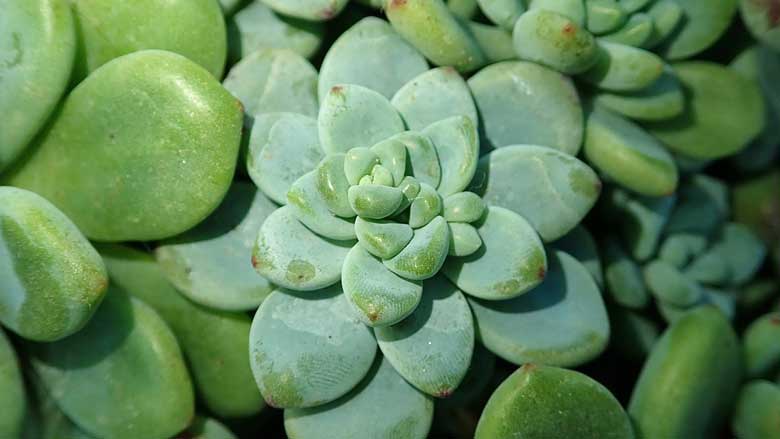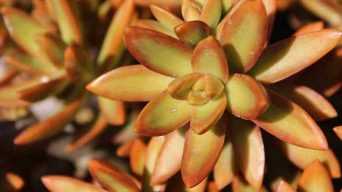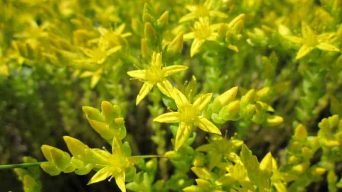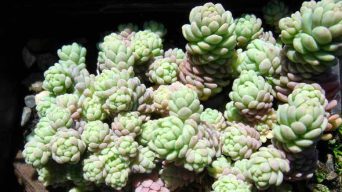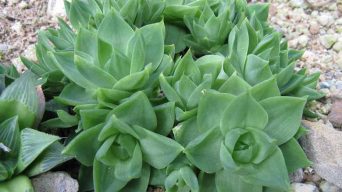The Sedum clavatum succulent plant is a beautiful, hardy, and low-maintenance houseplant.
This Sedum variety is not hard to care for or propagate. Still, you need to know how to take care of sedums properly before starting your propagation process.
The following guide will help you understand everything about sedums – their care, how they grow, what makes them thrive best, and how to make sure they stay healthy year-round!
Overview
The Sedum clavatum plant, also known as Tiscalatengo Gorge Sedum, is a member of the Crassulaceae family.
The Sedum clavatum plant has bluish-green leaves that form a beautiful rosette shape. When the leaves of Sedum clavatum are stressed, the tips turn light pink.
It can grow up to 6 inches tall (15 cm) and is typically 8 inches in width.
Sedum clavatum bears white star-shaped flowers in the late spring to early summer.
It’s best to grow this Sedum species plant outdoors. If grown indoors, it is unlikely that it will thrive or keep its color.
How To Care for Sedum Clavatum
Sedum clavatum care is not difficult, but it does require some careful attention to detail.
Here is some detailed information on how best to care for sedum plants indoors or outdoors.
Sun Exposure & Light Requirements
The Sedum clavatum needs at least six hours of sun exposure and prefers full sunlight.
It will grow in partial shade, but the leaves may never turn green or be as lush.
In a location with just four to five hours of sun per day, it would need supplemental lighting during winter until it can get more sun naturally.
The Sedum clavatum likes bright light and requires an east-facing window without shading from trees or nearby buildings.
It prefers to be outside during summer and will take full sun exposure as long as temperatures are low enough that it isn’t scorching hot.
When sedums begin flowering, they need 12 hours of light per day or more to encourage blooming success–a south window facing east, for instance.
Watering Requirements
The Sedum clavatum succulent plant is a drought-tolerant sedum.
It will do just fine with about one inch of water per week, but it prefers to be left alone in the winter and watered sparingly during the summer.
If you want your sedums to produce more foliage (or if they are getting too big), then give them light watering throughout spring and summer.
When grown outdoors, this Sedum does best when given an occasional deep soak on its leaves from time to time rather than daily drips or sprinkles, making sure not to overwater it.
Sedums prefer dry soil over moist soil. They should be watered only when the soil becomes dry to touch an inch below the surface.
This Sedum will not tolerate having its roots sitting in water, which can lead to problems such as rot.
Soil Requirements
The Sedum clavatum prefers soil that is well-drained and evenly moist.
Use only cacti or succulent potting soil mixes when planting your sedums in containers.
The succulents will rot if you put them into garden soil because they cannot drain quickly enough to prevent the water from suffocating the plant roots.
The Sedum clavatum is a succulent, so it needs moist soil that does not become waterlogged.
Temperature and Humidity
In general, sedums are suitable for hot and dry environments with low humidity.
The Sedum clavatum succulent plant thrives best in temperatures that range between 65°F (18°C) and 75°F (25°C), and an ideal level of humidity for this plant is around 50%.
Temperature and humidity are important for Sedums to thrive, as they tend to be susceptible to root rot.
Ensure that the sedums are not placed in cold temperatures or areas with high levels of moisture (i.e., under dripping faucets).
Fertilizing Sedum Clavatum
It is best to use a slow-release or time-released granular organic plant food.
These are perfect for sedums because they will feed the plants over an extended period.
Generally, it’s important not to fertilize sedums too frequently because doing so can contribute to succulent rot and root death.
Fertilizing this succulent during the spring and fall yields the best results.
Potting and Repotting
When potting the Sedum clavatum, use an open container with drainage holes on the bottom and fill it up to ¾ full of fast-draining cactus or succulent soil mix.
When repotting Sedum clavatum, put some fast-draining cactus or succulent mix on top of what’s already in their current pots and then move them up one size if needed.
Remove it carefully by gently tugging on the plant until you have enough dirt to hold onto while pulling out sedums from old containers.
After repotting them, water the Sedums well and place them in a sunny area with light breezes to help dry the soil.
Water sedums every two weeks or when they start looking wilted or going dormant if you don’t want any rot.
Pruning
Pruning sedums is a crucial part of maintaining the plants.
Sedum clavatum succulents are susceptible to root rot, so they must be trimmed occasionally.
You can trim sedums in two ways:
- Use your shears or pruning stick and cut off any dead leaves at their base near the ground
- Pinch back new growth with your fingers when they’re smaller than three inches tall.
Pruning sedums also help the plant keep its shape.
It’s a good idea to trim off any long or leggy stems that are sticking out and causing the Sedum clavatum to spread too thin across your garden bed, giving it an unkempt appearance.
Pests and Diseases
Sedum clavatum plants are prone to some pests and diseases.
The best way to avoid pests is to make sure that the plant has plenty of light, space, and water.
One of the most common Sedum clavatum pests is aphids, and they are usually found on new growths.
They suck plant juices from stems, leaves, flowers, and buds by piercing them with their mouthparts, promoting wilting and stunted growth.
Aphids cause deformed leaves because they secrete honeydew – this sticky substance falls onto foliage below, causing darkening spots called sooty mold.
The honeydew is often high in sugar content, making plants susceptible to fungal diseases like the black spot that thrive on moisture.
If you see aphids, use neem oil to kill them (or other sedum clavatum pests).
You should also watch for spider mites – these sedum clavatum pests that look like moving tiny specks of dust.
Spider mite eggs hatch in just one day, so check your plants regularly!
Treating this pest is easy: rub the affected area with cotton dipped in mineral oil, which suffocates and kills them.
One of the most common Sedum clavatum diseases is leaf spot.
It appears as circular, dark spots and can be caused by both fungi and bacteria that attack through water droplets (rain) or contact with other infected plants in your garden.
The best way to prevent this disease is by using a fungicide to kill the spores.
If Sedum clavatum plants are affected, then cut off all diseased foliage away from healthy ones.
Preventing these pests and diseases will help keep them looking excellent year after year!
How to Care for Sedum Clavatum in Winter
The Sedum clavatum is a hardy succulent that can still grow during the colder months.
However, it will not be as vigorous when growing in winter conditions and may take longer to recover if damaged.
To care for Sedum clavatum in winter:
- Keep the sedum clavatum in a frost-free location.
- Provide adequate bright light to maintain its health.
- Do not place sedum clavatum in direct sunlight, as it will scorch the plant.
- Provide water only when the soil is dry.
- Water sedums less frequently than you would in the summertime – once every two or three weeks should suffice!
- Remove any damaged leaves or stems from sedum clavatum before they rot on your plants!
In colder months, leave sedum plants outside only when temperatures are above 40 degrees Fahrenheit, or they will die quickly from frostbite.
How To Propagate Sedum Clavatum
A Sedum clavatum can be propagated by taking cuttings from its stem or leaves.
- Remove a section of the sedum clavatum stem or leaf.
- Allow the leaf or stem cuttings to callous over for several days
- Place the cutting in the soil and keep it moist.
The cuttings will root and start to grow.
It can take a few weeks for the cutting to produce roots, so you must make sure that they stay moist during this time.
Once the sedum clavatum has established roots, it can be transplanted into a pot.
If sedums are already growing nearby where you live, they will likely have seeds if grown outdoors, which would allow for more plants without any propagation techniques!
Is the Sedum Clavatum Toxic?
Sedum clavatum is not toxic.
However, keeping them away from pets and children is important because they can cause irritation if ingested or touch the skin in large amounts.
Clean the skin with soap and warm water, rinse well.
This is why it is always recommended to wear gloves when handling Sedum clavatum, so the oils from their leaves don’t get on your hands.
Final Thoughts
Sedums are a great addition to any succulent lover’s collection.
They come in many varieties and colors, so it is easy for anyone to find an appealing sedum plant that will fit their needs with ease.
A great option is the Sedum clavatum because it is very easy to propagate them.
This Sedum also has a beautiful, rosette shape that will work well as an addition to any garden or home décor setting.
It can take some time before they bloom or even produce clumps of sedum plants from cuttings.
Still, the wait is worth it for the beautiful sedum plants that will grace your garden!

